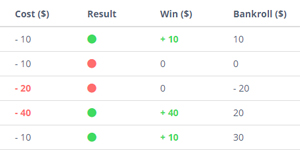D Alembert System
This system, named after an American mathematician, is one that resembles pretty much with the Martingale betting system. It is applied when betting on Black/Red, Even/Odd, because these bets have a 50-50 chance of win.
You must decide first which amount of money/chips you want to bet. After every loss, you add one unit (1 dollar or 1 chip) to the previous bet. After every win, you take out one unit from the original bet. Let’s say for example that you decide to bet 5 units. If you win, than the next bet will be of 4 units. If you loose, the next bet will be of 6 units. You can do this either until you run out of money, or until you hit the table limit. If you are a more aggressive player, you can decide to raise or decrease your bet by 2 units instead of 1, thus doubling your gain.
This system also has a reverse version. That is if you win, you add 1 unit, and if you loose, you take out 1 unit.
The d’Alembert system can be used on a number of different casino games, but it is very well suited. D'Alembert's principle, also known as the Lagrange–d'Alembert principle, is a statement of the fundamental classical laws of motion. It is named after its discoverer, the French physicist and mathematician Jean le Rond d'Alembert. It is an extension of the principle of virtual work from static to.
The difference between this system and the Martingale system is that when using this one you don’t double your bet amount when loosing, you just add one unit. In this way, if you loose a few times at the beginning, you don’t risk running out of money or hitting the table limit as fast as when using the Martingale. Sitting longer time at the table gives you more chances of winning.
Quick Guide to the D’Alembert System:
- Increase your bet by 1 if you lose
- Decrease your bet by 1 if you win
Pros

- Very simple to use
- Not aggressive- your bets won’t accelerate like in the Martingale System.
Cons

- You won’t claw back all of your losses
- Doesn’t alter the odds you get at the table.
More Details
The D’Alembert System is relatively easy to use- it is often used on the even money bets (e.g. red, black etc). The system was developed from French mathematician Jean Le Rond d’Alembert’s theory of equilibrium. In a nutshell, his theory was that iif something occurs with an equal chance of taking place (e.g. flipping a coin, or even/odd on a roulette wheel), and you start to see a lot of one outcome (lots of reds for example), then the opposite outcome must at some point “kick in”, so that the natural order of things can be restored. The system was thought to have been used by Charles Deville Wells in 1891 when he broke the bank in Monte Carlo, winning 1 million French Francs (around $13 million in today’s money).But others say he used the Martingale, or he cheated.

So, if you keep seeing reds, the wheel should switch to black, at some point in the future.
So how does this translate in to a system? Well, the D’Alembert System take the emotions out of the game, and to make your betting more methodical. The D’Alembert does not alter your odds, however. The basic theory is to try and bank your profits after a win (bet reduces) and claw back money after a loss (bet increases). It’s a gentle negative progression system (other negative progressions include the Fibonacci System and its more famous cousin: The Martingale.
How do You Play it?
Add a unit to your last bet if you lose and take away a unit if you win. it’s that simple.
Example

D'alembert System
Say you bet $10 on black and your bet loses, increase your next bet to $11. If this wins, take your next bet back down to 10.
D'alembert System Roulette
And you? What do you think about it? Let us know in the comments below and check our past results.